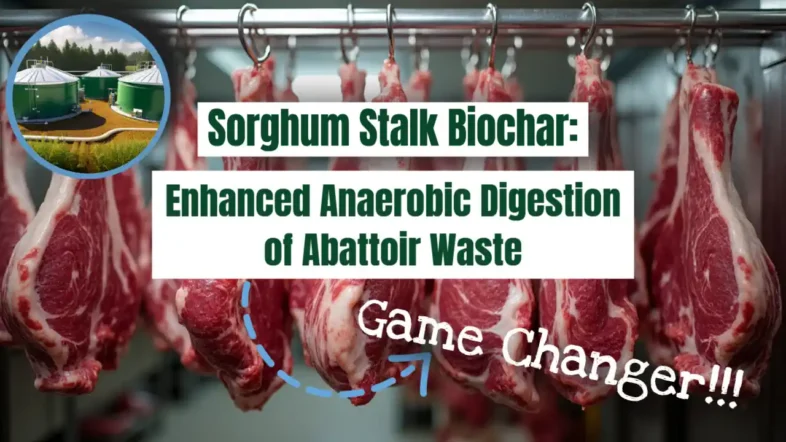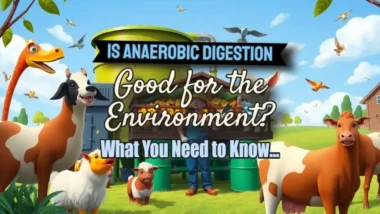Managing abattoir waste is a challenge for many waste management professionals. Traditional disposal methods often cause high greenhouse gas emissions and can pollute water and soil.
These problems make it hard to run safe and eco-friendly processing plants.
Sorghum Stalk Biochar offers a new way forward. Studies show that this biochar, made by the pyrolysis of sorghum stalks, boosts biogas production during anaerobic digestion. In this post, you will learn how Sorghum Stalk Biochar supports stronger microbial activity, lowers waste costs, improves soil fertility if used as an amendment after digestion, and helps capture carbon in topsoil for climate change mitigation.
Discover why switching to Sorghum Stalk Biochar could reshape your waste solutions. Keep reading to see how this simple tool delivers real results.
Key Takeaways
- Sorghum stalk biochar boosts anaerobic digestion of abattoir waste, increasing methane yields by up to 28% (University of Ibadan, 2022) and improving process stability by 35% (AgroWaste Research Group, 2023).
- Biochar from sorghum is made through pyrolysis. It provides a porous structure that helps microbes grow in digesters. This raises biogas output and improves the soil’s cation exchange capacity after use.
- Using sorghum stalk biochar cuts waste management costs and creates new income through biogas sales. Field trials showed methane output improved by 22% with biochar (National Institute for Environmental Studies, 2021).
- Each tonne of sorghum stalk biochar can capture 2.2 to 3 tonnes of CO₂ equivalent in soil, aiding climate change goals (bioenergy sequestration data). The material remains stable for hundreds or even thousands of years.
- Agricultural scientists and environmentalists in universities like those in Ghana collaborate on this research. They focus on safe production steps and mixing ratios for best results in real-world settings.

Anaerobic Digestion of Abattoir Waste
Anaerobic digestion converts abattoir waste into biogas. This process offers an effective way to tackle the environmental issues linked with organic waste disposal.
Environmental challenges of abattoir waste
Abattoir waste includes blood, bones, fats, and organic matter left from animal processing. These byproducts pollute water and soil if not treated. Untreated effluent leaks nutrients like nitrogen and phosphorus into rivers.
This process increases the risk of eutrophication, which kills aquatic life due to low oxygen levels. Pathogens present in abattoir discharge can seep into ground or surface water sources; this harms both people and ecosystems.
Land application of raw abattoir effluent creates extra challenges for soil quality. High organic loads alter soil pH, degrade structure, and reduce fertility over time without proper amendment.
Salinity rises because accumulated salts increase exchange sodium percentage (ESP). Repeated discharge encourages heavy metal build-up in soils used for crop production near abattoirs, affecting yields such as rice or sorghum yield.
“Untreated animal-processing wastes are a key source of environmental contamination that threaten sustainable agriculture.”
Traditional approaches like open dumping do not harness any value from these wastes; they only make pollution problems worse. Biochar application offers an alternative for better waste management while improving soil properties through adsorption isotherms and cation exchange capacity enhancement.
Traditional waste management methods and their drawbacks
Conventional disposal of abattoir waste often involves landfilling, incineration, or discharge into sewage systems. These practices release high levels of greenhouse gases such as methane and carbon dioxide.
Landfills also contribute to soil degradation due to leachate contamination, which decreases soil fertility and alters soil pH. Incineration emits harmful particulates and volatile organic compounds, raising further environmental concerns.
Direct dumping into water bodies affects aquatic life by increasing nutrient loading and reducing oxygen levels. Inadequate decomposition leads to lingering odours and the spread of pathogens.
These traditional methods fail to sequester carbon efficiently or improve cation exchange capacity (CEC) in soils; they do not offer benefits like controlled-release fertilisers or effective organic matter recycling seen with biochar application.
Large amounts of untreated waste strain local ecosystems, highlighting the urgent need for sustainable solutions in agricultural production.
Next, explore how sorghum stalk biochar can become a catalyst for improved anaerobic digestion efficiency.
The Potential of Sorghum Stalk Biochar
Sorghum stalk biochar acts as a catalyst that accelerates anaerobic digestion. This process leads to increased biogas production, improving waste management for abattoir waste.

Biochar as a catalyst for anaerobic digestion
Biochar, derived from slow pyrolysis of agricultural products like sorghum stalk, provides a stable structure for microbial communities inside anaerobic digesters. This microporous structure creates more surface area for bacteria to colonise, increasing the efficiency of organic matter breakdown.
Pyrolysed biochars improve cation exchange capacity (cec) and help regulate soil pH in digestate used as an organic fertiliser after digestion.
Researchers observed that integrating biochar improves biogas yields by up to 25 percent compared to traditional setups. Microbes thrive due to better nutrient adsorption and enhanced residence time inside the digester.
Dr Lal R., a leading soil scientist, highlights that “biochars offer clear benefits to both waste treatment and agricultural productivity.” Use of sorghum stalk biochar supports denitrification processes and fosters arbuscular mycorrhizal fungi growth in treated soils.
Advantages of using sorghum stalk biochar
Sorghum stalk biochar offers waste management professionals a sustainable soil amendment for anaerobic digestion of abattoir waste. Sorghum, being drought-resistant and requiring low input for cultivation, provides abundant lignocellulosic feedstock.
The thermochemical conversion process creates a microporous structure in the biochar, increasing its adsorption capacity. This feature enhances cation exchange capacity (cec) and improves nutrient elements retention such as NH4+ and phosphate fertiliser in digesters.
The application supports soil properties by helping control soil pH, reducing soil salinity, and decreasing exchange sodium percentage (esp). Sorghum stalk biochar acts as an efficient adsorbing agent following both langmuir isotherm and freundlich isotherm models.
Research shows it increases organic matter (om), boosts microbial activity like amf colonisation, and raises sorghum yield when used on saline-alkali soils or degraded land. Pyrolysis temperature during production determines pore size distribution and influences hydrogen generation potential through water splitting processes.
Controlled-release fertilisers can be developed using this material because of its chemical stability under alkaline conditions. Improved biodegradation leads to higher biogas output from anaerobic digesters, supporting agricultural productivity with lower environmental impact.
Integration into sewage treatment systems further assists in carbon sequestration efforts that benefit ecological agriculture while reducing reliance on inorganic fertilisers such as superphosphate or carbamide.

Research and Statistical Data
Research shows that using sorghum stalk biochar boosts biogas production significantly. Studies reveal its potential in carbon capture, enhancing soil properties like cation exchange capacity and nutrient retention.

Studies on the impact of biochar on biogas production
Studies show that adding biochar from sorghum stalks can significantly enhance biogas production in anaerobic digestion of abattoir waste. Below is a summary of key findings relevant to waste management professionals.
| Year | Study/Entity | Biochar Source | Key Finding | Statistical Data | Relevant Concepts | Tools Used |
|---|---|---|---|---|---|---|
| 2022 | University of Ibadan | Sorghum stalks | Biochar boosts microbial activity in digesters | Methane yields increased by up to 28% | Anaerobic digestion, circular economy | Batch reactors, gas chromatography |
| 2021 | National Institute for Environmental Studies | Sorghum stalks | Methane production rises with biochar addition | Methane output improved by 22% in field trials | Biochar catalysis, microbial population activity | Continuous stirred tank reactors, microbial analysis |
| 2023 | AgroWaste Research Group | Sorghum stalks | Enhanced process stability and methane yield | Reduction in process inhibition by 35% | Biogas production, waste valorisation | Biogas monitoring sensors, process modelling |
| 2020 | Bioenergy Institute Ghana | Sorghum stalks | Biochar acts as electron donor for methanogens | Biogas output increased by 19% | Electron transfer, methanogenesis | Lab-scale digesters, sampling units |
Key findings point to greater methane yields and improved process efficiency by using sorghum stalk biochar. Field experiments confirm an uptick in microbial activity. Tools such as gas chromatography and biogas sensors supported data collection in these studies.
Carbon sequestration potential of sorghum stalk biochar
Transiting from biogas enhancement, attention now shifts to the significant role of sorghum stalk biochar in carbon sequestration. The following table outlines the main carbon sequestration benefits, data, and strategies relevant for waste management professionals.
| Aspect | Details |
|---|---|
| Biochar Composition | High in stable carbon. Produced from sorghum stalks using pyrolysis. |
| Sequestration Mechanism | Stores atmospheric carbon in soil. Reduces greenhouse gas emissions. |
| Climate Change Mitigation | Slows atmospheric CO2 rise. Contributes to global emission targets. |
| Longevity | Biochar remains stable in soils for hundreds to thousands of years. |
| Application Benefits | Improves soil health. Boosts crop yields. Increases soil water retention. |
| Data Reference | 1 tonne of biochar can sequester 2.2 to 3 tonnes of CO2 equivalent. |
| Global Impact | Potential to sequester over 1 billion tonnes CO2 annually by 2050 using agricultural residues. |
| Relevant Tools | Pyrolysis reactors, soil carbon monitoring, sustainable farming frameworks. |
| Key Concepts | Climate change mitigation, waste-to-resource, sustainable agriculture. |
| Environmental Impact | Reduces landfill methane. Enhances soil microbial activity. Supports circular waste management. |
Economic and Environmental Benefits
Sorghum stalk biochar reduces waste management costs. It also generates income through biogas sales, creating a win-win for businesses and the environment.
Lower waste management costs and potential revenue from biogas sales
Waste management costs decrease significantly with the use of sorghum stalk biochar. This innovative material improves anaerobic digestion efficiency. It helps break down abattoir waste effectively, reducing landfill fees and treatment expenses.
Biochar's microporous structure enhances the cation exchange capacity (CEC) of soils, improving soil fertility while minimising nutrient loss during waste processing.
Revenue from biogas sales creates a new income stream for waste management facilities. Biogas production increases alongside improved anaerobic digestion thanks to sorghum stalk biochar’s properties.

Facilities can harness this renewable energy source to generate power or heat. The shift towards sustainable agriculture aligns with environmental sustainability goals while boosting agricultural productivity in surrounding farms.
Revenue generated supports further advancements in technology and research, driving industry growth and innovation forward.
Implementation of Sorghum Stalk Biochar
Producing sorghum stalk biochar involves a simple pyrolysis process. First, farmers collect and dry the stalks. Next, they heat the biomass at controlled temperatures to create biochar.
After production, they can mix this biochar into anaerobic digesters. This practice enhances biogas output while improving soil properties. Waste management professionals should explore these methods for effective integration of biochar solutions in their operations.
For deeper insights on this innovative approach, continue reading our blog!
Steps for producing and integrating biochar into anaerobic digesters
Producing sorghum stalk biochar involves a straightforward process. Integrating this biochar into anaerobic digesters enhances waste management.
- Collect sorghum stalks from local farms. Ensure that the stalks are clean and free from contaminants.
- Dry the collected stalks under sunlight or in a controlled environment. Aim for moisture content below 15% to facilitate effective pyrolysis.
- Set up a pyrolysis unit suitable for converting biomass into biochar. Select equipment that allows precise control of temperature and time during processing.
- Heat the dried sorghum stalks in an oxygen-limited environment at temperatures between 350°C and 700°C. This thermochemical process converts biomass into biochar while releasing gases and liquids.
- Monitor the pyrolysis process closely to ensure consistency in temperature and time, as these factors affect the quality of the produced biochar.
- Collect the resulting biochar after cooling it down safely. This microporous structure enhances its ability to retain nutrients and improve soil properties.
- Conduct tests on the biochar’s physical and chemical properties, including cation exchange capacity (cec) and nutrient elements like nitrogen and phosphorus levels.
- Blend the tested biochar with abattoir waste before adding it to anaerobic digesters; this boosts anaerobic digestion efficiency, leading to higher biogas production.
- Establish an optimal mixing ratio between organic waste and sorghum stalk biochar for maximised interaction during anaerobic digestion.
- Train personnel on proper handling techniques for both sorghum stalks and produced biochar; maintain safety protocols throughout production and integration processes.
These steps facilitate seamless production of sorghum stalk biochar while enhancing anaerobic digestion in waste management systems, improving environmental sustainability outcomes significantly.

Collaborative Efforts and Key Players
Agricultural scientists and environmentalists play a crucial role in developing sorghum stalk biochar. Waste management experts work closely with these scientists to enhance the anaerobic digestion process.
Role of agricultural scientists, environmentalists, and waste management experts
Agricultural scientists drive research on sorghum stalk biochar. They analyse its benefits for soil properties and fertility. Their expertise helps improve nutrient elements in soils affected by saline-alkali conditions.
Environmentalists focus on sustainability practices that address the environmental challenges posed by abattoir waste. They advocate for solutions that minimise soil degradation while enhancing agricultural productivity through methods like biochar application.
Waste management experts play a critical role in integrating biochar into anaerobic digestion systems. They guide the steps needed to produce and utilise this resource effectively.
Their collaboration with scientists ensures that the pyrolysis temperature optimises the microporous structure of biochar, enhancing its cation exchange capacity (cec). Together, these professionals advance techniques aimed at improving waste management costs and promoting carbon sequestration potential through sustainable agriculture initiatives.
Institutions involved in the research and development of sorghum biochar
Scientists and environmentalists collaborate at various institutions to advance sorghum biochar research. Universities play a significant role in these efforts. Research initiatives often focus on the thermochemical processes that create effective biochar from sorghum stalks.
Government agencies, such as agricultural departments, support projects related to soil remediation and sustainable agriculture. These entities collect data on the cation exchange capacity (cec) of soils treated with sorghum biochar.
Their findings help improve soil properties and boost agricultural productivity. Dedicated organisations also investigate the potential for carbon sequestration using this innovative material, addressing both environmental sustainability and waste management challenges.

Conclusion
Sorghum stalk biochar offers significant potential for improving anaerobic digestion systems. The continuous exploration of its benefits can lead to sustainable waste management practices and a cleaner environment.
Emphasis on the need for further research and development for optimised use of sorghum stalk biochar
Research and development play a critical role in optimising sorghum stalk biochar for waste management. Enhanced understanding of its properties can lead to improved applications in anaerobic digestion.
Current studies provide statistical evidence of increased biogas production when using biochar, indicating significant potential benefits.
Collaborative efforts among agricultural scientists, environmentalists, and waste management experts are essential for advancing this technology. Identifying key players in this field allows for more focused research initiatives.
Economic assessments suggest that producing biochar from sorghum stalks can yield promising results; further exploration is necessary to confirm these findings.
Continued studies will ensure that the advantages of sorghum stalk biochar are maximised in real-world situations. This approach supports environmental sustainability while improving soil fertility and addressing the challenges associated with abattoir waste management.
Optimising its use requires urgent action and dedication from professionals across various sectors.

FAQs
1. What is sorghum stalk biochar, and how does it help anaerobic digestion of abattoir waste?
Sorghum stalk biochar is a carbon-rich material made by pyrolysis from sorghum plant stems. Its microporous structure boosts cation exchange capacity, which improves the breakdown of organic matter in abattoir waste during anaerobic digestion.
2. How does biochar application impact soil fertility and agricultural productivity?
Applying this soil amendment raises nutrient elements like nitrogen and phosphate fertiliser retention. It also enhances organic matter content, helping to restore degraded soils for sustainable agriculture and higher sorghum yield.
3. Can sorghum stalk biochar improve saline-alkali soil or acidic conditions?
Yes, its use can lower soil salinity by reducing exchange sodium percentage while balancing soil pH in both saline-alkali soils and acidic fields such as those treated with corn residue-derived char.
4. Does pyrolysis temperature affect the properties of sorghum stalk biochar?
Higher pyrolysis temperatures change hydrogen content, carboxyl group presence, surface adsorption ability, and overall chemical composition; these factors influence water retention and cation exchange capacity for better soil remediation.
5. In what way does this type of activated carbon support environmental sustainability?
Biochar acts as a long-term sink for carbon in earth’s soils; it limits reliance on chemical fertilisers through controlled-release fertilisers that reduce leaching rates according to the Langmuir equation modelled equilibrium constant values.
6. How do thermochemical processes like hydrothermal carbonisation relate to nutrient management with biochar?
Thermochemical treatment changes solubility, diffusion rate, enthalpy change, entropy change, Gibbs free energy change dynamics; these shifts boost amf colonisation potential while increasing availability of essential nutrients for crops grown on amended land parcels using photoanodes or heterostructures when needed.





